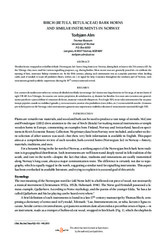| dc.contributor.author | Alm, Torbjørn | |
| dc.date.accessioned | 2016-03-02T07:54:03Z | |
| dc.date.available | 2016-03-02T07:54:03Z | |
| dc.date.issued | 2015-11-30 | |
| dc.description.abstract | Wooden horns wrapped in coiled birch bark (Norwegian: lur) have a long history in Norway, dating back at least to the 7th century AD. By
the Vikings, they were used for various signalling purposes, e.g. during battles. More recent uses are generally peaceful—to celebrate the
opening of fairs, announce bishop visitations etc. In the 19th century, playing such instruments was as a popular past-time when herding
cattle, and, if needed, to scare off predators (bears, wolves, etc.) or signal for help. Common throughout the southern part of Norway, such
instruments gained symbolic importance during the 19th century national revival. | en |
| dc.identifier.citation | Journal of the Botanical Research Institute of Texas 2015, 9(2):433-448 | en_US |
| dc.identifier.cristinID | FRIDAID 1304470 | |
| dc.identifier.issn | 1934-5259 | |
| dc.identifier.uri | https://hdl.handle.net/10037/8600 | |
| dc.identifier.urn | URN:NBN:no-uit_munin_8160 | |
| dc.language.iso | eng | en_US |
| dc.rights.accessRights | openAccess | |
| dc.subject | VDP::Matematikk og Naturvitenskap: 400::Zoologiske og botaniske fag: 480::Vegetasjonshistorie: 495 | en_US |
| dc.subject | VDP::Mathematics and natural science: 400::Zoology and botany: 480::Vegetation history: 495 | en_US |
| dc.title | Birch (Betula, Betulacae) bark horns and similar instruments in Norway. | en_US |
| dc.type | Journal article | en_US |
| dc.type | Tidsskriftartikkel | en_US |
| dc.type | Peer reviewed | en_US |


 English
English norsk
norsk